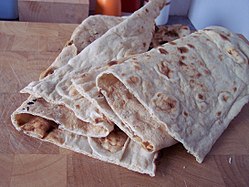 | |
| Type | Wafer |
|---|---|
| Course | Dessert |
| Place of origin | Malolos City, Bulacan |
| Region or state | Central Luzon |
| Created by | Socorro V. Malonzo |
| Invented | 1972 |
| Main ingredients | Wheat flour, water, sugar |
| Ingredients generally used | Sesame seeds |
| Variations | Angel cookies / Cloister cookies |
Aparon (from portmanteau 'Apa' wafer + 'chicharon' puffed food product) is a Filipino dessert made from toasted unconsecrated hostia (communion wafers) drizzled with caramelized sugar and, optionally, sesame seeds.
It was invented in 1972 by Socorro Vistan Malonzo who learned to bake communion wafers from the Augustinian Sisters of Our Lady of Consolation of the Colegio de Nuestra Señora del Carmen (now La Consolacion University) in Malolos City, Bulacan and had supplied communion wafers to the nearby churches of Bulacan and Pampanga as a livelihood. She invented the dessert in an effort to make better use of the full communion wafer sheet instead of having the trimmings disposed as fish and animal feed. [1] [2] [3]
A variation of this dessert, known as angel cookies, was invented in the mid-1980's by Missionary Sisters Servants of the Holy Spirit Sr. Anesilde Antonio similarly in an effort to make use of the excess cutouts of communion wafers. However, this variant has the wafers incorporated into cookie dough in a similar fashion to chocolate chip cookies. [4]

